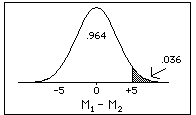One- and Two-Tailed Tests (3 of 4)
In the example, the one-tailed probability would be the probability of obtaining a value of M1- M2 greater than or equal to five given that the difference between population means is zero.

The shaded area in the figure is greater than five. The figure shows that the one-tailed probability is 0.036.
It is easier to reject the null hypothesis with a one-tailed than with a two-tailed test as long as the effect is in the specified direction. Therefore, one-tailed tests have lower Type II error rates and more power than do two-tailed tests. In this example, the one-tailed probability (0.036) is below the conventional significance level of 0.05 whereas the two-tailed probability (0.072) is not. Probability values for one-tailed tests are one half the value for two-tailed tests as long as the effect is in the specified direction.